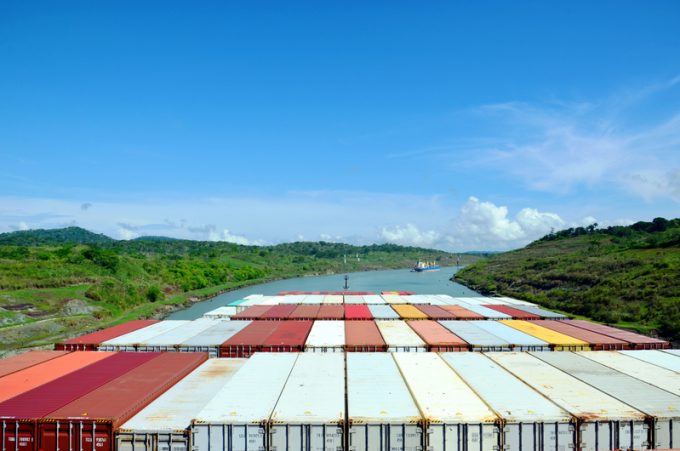Control of Wilson Sons could boost MSC dominance in Brazil
MSC’s acquisition of Brazilian operator Wilson Sons has raised eyebrows among forwarders in the region, ...
GM: RAISING THE ROOF GGM: IN FULL THROTTLE GZIM: MAERSK BOOST KNIN: READ-ACROSSMAERSK: NOT ENOUGHMAERSK: GUIDANCE UPGRADEZIM: ROLLERCOASTERCAT: HEAVY DUTYMAERSK: CATCHING UP PG: DESTOCKING PATTERNSPG: HEALTH CHECKWTC: THE FALLGXO: DEFENSIVE FWRD: RALLYING ON TAKEOVER TALKODFL: STEADY YIELDVW: NEW MODEL NEEDEDWTC: TAKING PROFIT
GM: RAISING THE ROOF GGM: IN FULL THROTTLE GZIM: MAERSK BOOST KNIN: READ-ACROSSMAERSK: NOT ENOUGHMAERSK: GUIDANCE UPGRADEZIM: ROLLERCOASTERCAT: HEAVY DUTYMAERSK: CATCHING UP PG: DESTOCKING PATTERNSPG: HEALTH CHECKWTC: THE FALLGXO: DEFENSIVE FWRD: RALLYING ON TAKEOVER TALKODFL: STEADY YIELDVW: NEW MODEL NEEDEDWTC: TAKING PROFIT

Evergreen’s latest addition to its neo-panamax fleet had to offload 1,400 containers to pass through the Panama Canal, due to low-water restrictions.
The event starkly highlights the problems the vital waterway and its users are facing.
The Ever Max, capable of carrying 17,312 teu and delivered to Evergreen in June, had to offload the boxes before it could enter the canal’s neo-panamax locks. They had to be moved by rail across the isthmus for pick-up at the Atlantic end of the waterway.
The cause was draught restrictions imposed by the Panama Canal Authority (ACP) in response to persistent low water levels from the drought that has hampered transits since May. Rainfall in the first four months of the year brought water levels roughly to a par with 2019 – the lowest level in two decades.
ACP imposed a draught restriction to 44.5ft from 24 May, which increased to to 44ft one week later.
A planned restriction to 43.5ft was postponed in June, but the authority did reduce the number of transits through the canal to 32 a day, with 10 crossings at the neo-panamax locks and 22 at the panamax locks. This was to reduce salination of the freshwater in the canal and the lakes and rivers that make up its watershed, which also provides fresh water to three cities, including the capital.
According to ACP, it takes around 50 million gallons of fresh water to move a ship through a lock. The panamax locks lose more fresh water than the neo-panamax locks, which have a recovery system that can reclaim 60% of the water.
With transits capped, the canal authority advised shipowners to reserve slots for crossings, which soon meant they would have to go for an ‘auction’ of slots, but these consistently exceed $350,000, according to one report.
Container lines like CMA CGM and Hapag-Lloyd have reacted to the restrictions by adding canal transit surcharges ranging from $300 per teu to $500.
Until the Ever Max arrived carriers did not have to offload containers to meet the draught restrictions, opting to limit loads at origin – although this has translated into significant load reductions. According to one estimate, the 44ft limit calls for a reduction of up to 40% on a neo-panamax vessel.
And relief is not in sight, as the rainy season has failed to raise water levels. Last week canal administrator Ricaurte Vásquez called the situation “unusually severe” and warned that “significant restrictions” would remain in place until September next year.
He noted that past weather cycles brought drought in one out of five years, but that this had increased to one in three years.
For the canal and its users this poses a fundamental challenge as more than 3% of global trade passes through it. The canal is particularly important for US importers, as their cargo accounts for 73% of its traffic, said Mr Vásquez.
However, so far US companies appear unfazed by the canal’s deteriorating capacity to handle traffic. Forwarder AIT has not re-routed any cargo in response to the recent restrictions, a spokesman reported, adding: “We would, of course, accommodate any customer requesting their cargo be re-routed from Gulf or east coast ports to west coast ports.”
Panama Canal transit times beat shipping cargo from China to the US via Suez: ocean transit from Shenzhen to Miami on that route takes 41 days, but 35 through the Panama Canal.
However, this is still much slower than a direct transpacific transit to US west coast ports, and more expensive. The completion of contract negotiations between west coast port workers and employers has banished fears of disruption for now, and cargo owners have duly shifted flows from east and Gulf ports back to the shortest ocean route.
But the prospect of lasting restrictions in the Panama Canal will prompt them to reconsider their routing arrangements.
Comment on this article